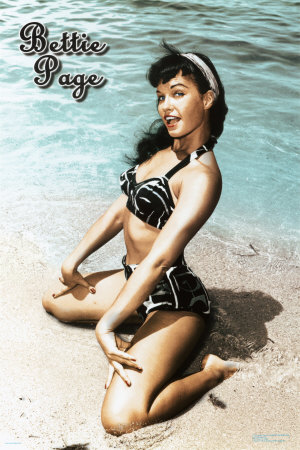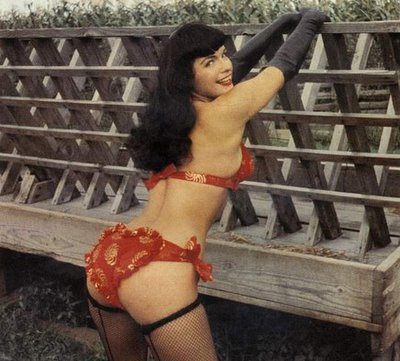The Notorious Bettie Page
From fifties
Contents |
[edit] WHO IS "THE GIRL WITH THE PREFECT FIGURE"
Bettie Page, with her killer curves, sweet smile, and sparkling eyes, combined with unique, black-banged hair and uninhibited modeling style was the poster girl (literally) of the 1950s pin-ups. Her form of expression could be found in countless men's magazines such as Wink, Titter, Eyefull, and most famously Playboy. Other than magazines Bettie was depicted in mail order photos, ads, paperback and album covers. She had the effortless combination of the girl-next-door ideal and dangerous vixen like sensuality that still goes on to push the thriving cult following of today.
[edit] The "Innocent" Girl
Bettie Page, the girl who would grow up to become most famous and admired American pin-up model of the 1950s was born in Nashville, Tennessee on April 22 1923. Bettie was the second of six children to poor parents, Roy and Edna Page. Her childhood years where turbulent; spurred by the family moving frequently due to economic instability. Her parents divorced when she was 10, sending Bettie and a sister to an orphanage for a better part of a year until Edna could find stability. In 1940, Bettie graduated from high school just 0.25% short of valedictorian, and went onto George Peabody College, with the idea of becoming a teacher. But while there she found a love of acting and sought to pursue that avenue of life. After college, Bettie traveled from California to Florida to Haiti until her marriage to a high school classmate, Billy Neal ended in 1947
[edit] The Legendary Pin-Up
Although she aspired to become an actress, the way in which Bettie Page would find her place wasn’t the Hollywood tale, nor was it a horror show. In 1950, as a way to pay the bills, Bettie found work as a secretary in New York City. While walking along the Coney Island Shore she met, Jerry Tibbs, an aspiring photographer who offered to put together a portfolio if she would be willing to model. And that is where Betty Page’s life as a Pin-Up began. In 1951, Bettie starts life as a full-time model after meeting Irving Klaw, [[1]]who would grow to be known as, “The Pin-Up King.” The photographers taken by Klaw of Page in various bondage states would both push her forward in popularity as well as later thrust her into the spotlight of immorality associated with the 1950s. The majority of her sessions were sold to subscription based customers, which allowed the buyer to set up the scene. Around this same time Howard Hughes, contacted Page about appearing in legitimate movies, but that never happened because Bettie refused the casting couch system, rejecting overtures from studio executives and Hughes. When Bettie met Bunny Yeager in 1954 they would collaborate to create some of her most famous photographs, particularly the infamous “Jungle Bettie” where Yeager shot her in the Africa USA wildlife park n Boca Raton, with Page wearing a leopard-print outfit and posing among the trees with various animals. In 1955, Page became Playmate of the Month for January in the still young, Playboy Magazine. [[2]] This spread came at the height of her fame, which corresponded with Page turning 32 years old, making her not only a Pin-Up but also one that broke age barriers. In that same year, Bettie won the title of “Miss Pinup Girl of the World. Bettie Page demanded the spotlight for several years, while the average length of a models fame were measured in months. It lasted until 1957, when Page all but disappeared from public life. But in the years of Bettie Page’s rise to fame and the hold her photos had on the public, she was estimated to have been in over 20,000 photographs, which is more than Marilyn Monroe and Cindy Crawford combined.
[edit] The Bettie Look
Bettie Page is an icon, and like all other icon she had her trademark looks, her hair being a quintessential part of that. The trademark look that she would forever be known for, Jerry Tibbs suggested in the summer of 1950 to compensate for her high forehead, advise that she comb her bangs down in front. This simple suggestion would become the backbone of her image.
Along with her hair, Bettie Page had a signature look, which can be viewed as a bit ironic considering how little clothing she wore at times. Page made it a point to always try and wear clothing which she created giving herself a signature look; always showing off her assets, long legs, and large bust. The key to Page’s look wasn’t in that it was overtly purposeful; the theme she was portraying was just emphasized by her outfits and appearance
[edit] Filmography
- Striporama (1953)
- Teaserama (1955)
- Varietease (1954)
(The above three being full-length burlesque films)
- Irving Klaw Bondage Classics, Volume I
- Irving Klaw Bondage Classics, Volume II
- Bettie Page: Pin Up Queen (Cult Epics, 2005)
- Bettie Page: Bondage Queen (Cult Epics, 2005)
[edit] The Power of Page
With her fame in the 50s Betty Page gain a place in the history books, but it wasn’t until decades later that her art would find its biggest audience. As a symbol of the fifties, Page was and is the girl-next-door with a bad side. Today her influence still resonates in the form of photographers, impersonators, clothing lines, a wide variety of merchandise from jewelry to guitars. Her image can be seen on pretty much any surface that will hold it. She has become a halloween costume, tattoo item, and the perfect example to use in comic books (the famous DC Comic character, Poison Ivy, was in early drawings fashioned after Page.) From books to movies, the legend of Betty Page is a story that gives power to women and something else to men. The secretary, who became a vixen, yet never seemed to lose that girl next door appeal. The following is a list of major publications on Bettie:
Books:
- Betty Page Confidential" by Stan Corwin Productions and Bunny Yeager (1994)”
- Bettie Page: Queen of Hearts" by Jim Silke et al. (1995)”
- Bettie Page: The Life of a Pin-Up Legend" by Karen Essex and James L. Swanson (1996) authorized biography with foreword by Bettie herself “
- Betty Page: Queen of Pin-Up" by Bunny Yeager (1996)"
- The Real Bettie Page: The Truth about the Queen of the Pinups" by Richard Foster (1997)"
Magazines/articles:
- Betty Page: Private Peeks" vol. 1-4 by J. B. Rund, (1978-1980)"
- The Betty Pages" issues 1-9 by Greg Theakston (1987-1993)"
- The Legend of Betty Page" by Elizabeth Snead. USA Today, (June 5, 1991)"
- In Search of Bettie Page" by Karen Essex. L.A. Weekly (Oct. 11, 1991)"
- The Betty Boom" by Buck Henry. Playboy, (Dec. 1992)”
- The Real Betty Page" by Bunny Yeager. Interview, (July 1993)"
- The Real Bettie Page" by Karen Essex and James L. Swanson. Playboy, (Dec. 1995)"
- Playboy Interview: Bettie Page" by Kevin Cook. Playboy (Jan. 1998)"
TV shows:
- Lifestyles of the Rich and Famous ( Nov. 1992 - Bettie communicates with the public for the first time since 1957.)"
- The E! True Hollywood Story - Bettie Page: From Pinup to Sex Queen (April 1997)"
[edit] References
http://en.wikipedia.org/wiki/Bettie_Page
http://www.tv.com/bettie-page/person/454642/trivia.html
http://www.popsubculture.com/pop/bio_project/bettie_page.html







